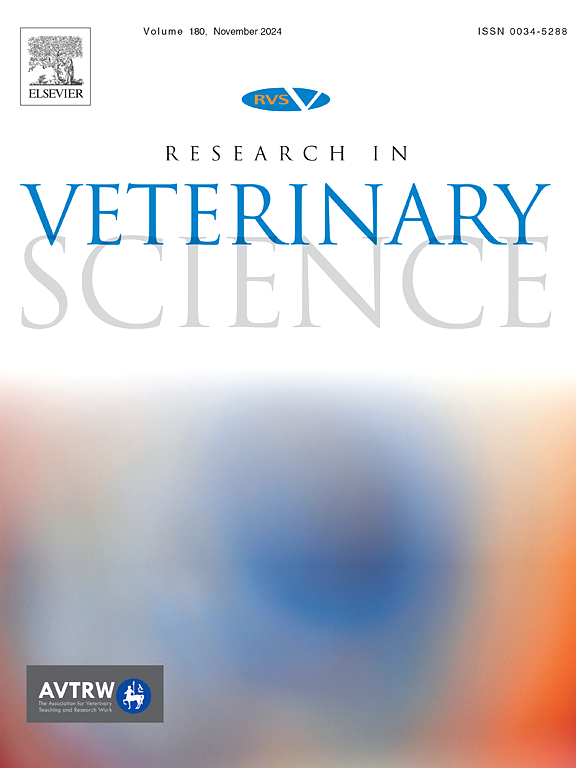加拿大西部小牛处理者对牛处理的态度:处理训练的作用和对肉牛福利的看法
IF 2.2
3区 农林科学
Q1 VETERINARY SCIENCES
引用次数: 0
摘要
对加拿大西部的118名小牛饲养员进行了调查,以确定:(1)对肉牛和处理的态度;(2)处理训练对处理态度的影响;(3)牛福利评估策略与改善重点领域;(4)处理培训的参与与展望。受访者同意与积极态度有关的陈述,包括正确的处理方法、知识和耐心对有效处理牛的重要性。他们也同意牛的认知能力和良好的处理设施的重要性,而不同意处理牛不需要什么知识和使用棍棒、打牛和大喊大叫的说法。参与者报告使用的主要福利评估指标是一般健康和身体状况得分,他们优先考虑改善营养、群体健康计划和疼痛管理。经济回报和责任感是改善牛福利的主要动机。大多数受访者参加过牛处理培训,包括亲自动手演示(33.7%)、亲自不动手演示(10.9%)、在线模块与动手演示相结合的混合形式(19.6%)和完全在线培训(35.9%)。安全和学习的愿望是参加处理培训的主要动机。受访者承认处理培训对提高处理技能的好处,并强烈同意处理培训应侧重于教授耐心策略。虽然训练影响态度,但训练方式的影响是不一致的。各种训练方法的有效性可能因个人或环境而异,这表明需要进一步研究,以确定哪种方法对训导员和牛都能产生最积极的结果。本文章由计算机程序翻译,如有差异,请以英文原文为准。
Attitudes towards cattle handling among Western Canadian cow-calf handlers: The role of handling training and perspectives on beef cattle welfare
Western Canadian cow-calf handlers (n = 118) were surveyed to determine: (1) attitudes towards beef cattle and handling; (2) influence of handling training on handling attitudes; (3) cattle welfare assessment strategies and improvement prioritization areas, and (4) involvement in and perspectives about handling training. Respondents agreed with statements related to positive attitudes, including the importance of proper handling practices, knowledge, and patience for effective cattle handling. They also agreed with statements favouring cattle cognitive abilities and the importance of good handling facilities, while disagreed with statements indicating little knowledge is required to handle cattle and the use of prods, hitting cattle, and yelling. Key welfare assessment indicators that participants reported using were general health and body condition scores, and they prioritized improving nutrition, herd health programs, and pain management. Economic returns and a sense of responsibility were major motivations for improving cattle welfare. Most respondents had attended cattle handling training, including in-person with hands-on demonstrations (33.7 %), in-person without hands-on demonstrations (10.9 %), hybrid formats combining online modules with hands-on demonstrations (19.6 %), and fully online training (35.9 %). Safety and desire to learn were major motivations for participating in handling training. Respondents acknowledged the benefits of handling training on improving handling skills and strongly agreed that handling training should focus on teaching patience strategies. Although training influenced attitudes, impacts of training modalities were inconsistent. The effectiveness of various training approaches may vary depending on the individual or context, indicating a need for further research to determine which methods yield the most positive outcomes for both handlers and cattle.
求助全文
通过发布文献求助,成功后即可免费获取论文全文。
去求助
来源期刊

Research in veterinary science
农林科学-兽医学
CiteScore
4.40
自引率
4.20%
发文量
312
审稿时长
75 days
期刊介绍:
Research in Veterinary Science is an International multi-disciplinary journal publishing original articles, reviews and short communications of a high scientific and ethical standard in all aspects of veterinary and biomedical research.
The primary aim of the journal is to inform veterinary and biomedical scientists of significant advances in veterinary and related research through prompt publication and dissemination. Secondly, the journal aims to provide a general multi-disciplinary forum for discussion and debate of news and issues concerning veterinary science. Thirdly, to promote the dissemination of knowledge to a broader range of professions, globally.
High quality papers on all species of animals are considered, particularly those considered to be of high scientific importance and originality, and with interdisciplinary interest. The journal encourages papers providing results that have clear implications for understanding disease pathogenesis and for the development of control measures or treatments, as well as those dealing with a comparative biomedical approach, which represents a substantial improvement to animal and human health.
Studies without a robust scientific hypothesis or that are preliminary, or of weak originality, as well as negative results, are not appropriate for the journal. Furthermore, observational approaches, case studies or field reports lacking an advancement in general knowledge do not fall within the scope of the journal.
 求助内容:
求助内容: 应助结果提醒方式:
应助结果提醒方式:


